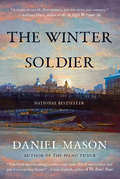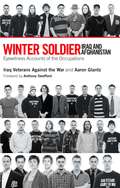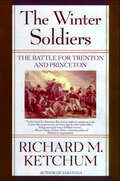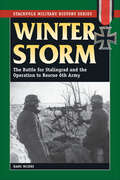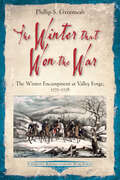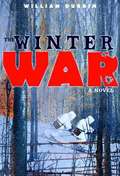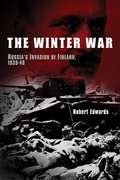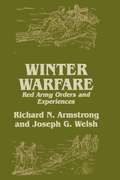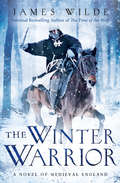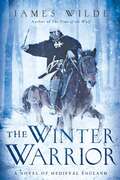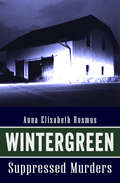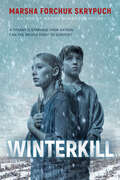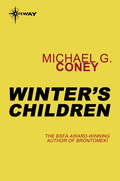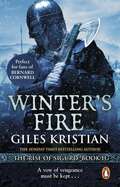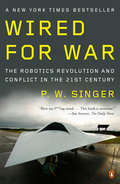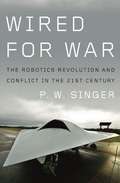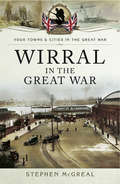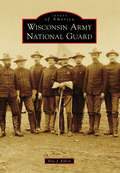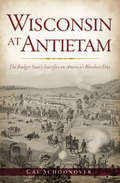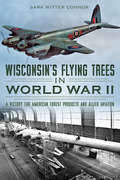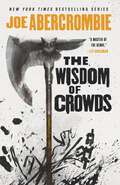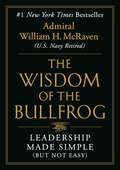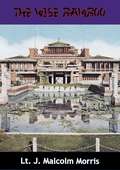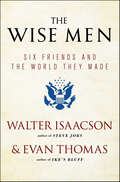- Table View
- List View
The Winter Soldier
by Daniel Mason"A dream of a novel... Part mystery, part war story, part romance." --Anthony Doerr, author of All the Light We Cannot SeeVienna, 1914. Lucius is a twenty-two-year-old medical student when World War I explodes across Europe. Enraptured by romantic tales of battlefield surgery, he enlists, expecting a position at a well-organized field hospital. But when he arrives, at a commandeered church tucked away high in a remote valley of the Carpathian Mountains, he finds a freezing outpost ravaged by typhus. The other doctors have fled, and only a single, mysterious nurse named Sister Margarete remains.But Lucius has never lifted a surgeon's scalpel. And as the war rages across the winter landscape, he finds himself falling in love with the woman from whom he must learn a brutal, makeshift medicine. Then one day, an unconscious soldier is brought in from the snow, his uniform stuffed with strange drawings. He seems beyond rescue, until Lucius makes a fateful decision that will change the lives of doctor, patient, and nurse forever.From the gilded ballrooms of Imperial Vienna to the frozen forests of the Eastern Front; from hardscrabble operating rooms to battlefields thundering with Cossack cavalry, The Winter Soldier is the story of war and medicine, of family, of finding love in the sweeping tides of history, and finally, of the mistakes we make, and the precious opportunities to atone.
Winter Soldier: Iraq and Afghanistan
by Anthony Swofford Aaron Glantz Iraq Veterans Against the War"The only way this war is going to end is if the American people truly understand what we have done in their name."--Kelly Dougherty, executive director of Iraq Veterans Against the WarIn spring 2008, inspired by the Vietnam-era Winter Soldier hearings, Iraq Veterans Against the War gathered veterans to expose war crimes in Afghanistan and Iraq. Here are the powerful words, images, and documents of this historic gathering, which show the reality of life in Afghanistan and Iraq.Iraq Veterans Against the War argues that well-publicized incidents of American brutality like the Abu Ghraib prison scandal and the massacre of an entire family of Iraqis in the town of Haditha are not the isolated incidents perpetrated by "a few bad apples," as many politicians and military leaders have claimed. They are part of a pattern, the group says, of "an increasingly bloody occupation." "Here is the war as it should be reported, seeing the pain, refusing to sanitize an unprovoked attack that has killed over one million people. All over America are victims who have returned from this conflict with hideous wounds -- wounds that turn the lives of the entire family upside down. And the American people are not seeing this. Until now. "Winter Soldier, an enormously important project of Iraq Veterans Against the War, cuts this debacle to the bone, exposing details hard to come by and even harder to believe. This is must reading for patriots who have already begun the effort to insure that this never happens again." --Phil Donahue "Winter Soldier makes us feel the pain and despair endured by those who serve in a military stretched to the breaking point by stop-loss policies, multiple combat tours, and a war where the goals and the enemies keep shifting ... [and] also make[s] us admire the unbreakable idealism and hope of those men and women who still believe that by speaking out they can make things better both for themselves and for those who come after them."--San Francisco Chronicle Formed in the aftermath of the US invasions of Iraq and Afghanistan, Iraq Veterans Against the War (IVAW) was founded in 2004 to give those who have served in the military since September 11, 2001, a way to come together and speak out against an unjust, illegal, and unwinnable war. Today, IVAW has over seven hundred members in forty-nine states, Washington, DC, Canada, and on military bases overseas. Aaron Glantz is an independent journalist who has covered the Iraq War from the front lines. He is the author of How America Lost Iraq (Tarcher) and a forthcoming book on the Iraq War from the University of California Press.Anthony Swofford is the author of Jarhead: A Marine's Chronicle of the Gulf War and Other Battles.
The Winter Soldiers: The Battle for Trenton and Princeton
by Richard M. KetchumThe Winter Soldiers is the story of a small band of men held together by George Washington in the face of disaster and hopelessness, desperately needing at least one victory to salvage both cause and country. In the fall of 1776 the British delivered a crushing blow to the Revolutionary War efforts. New York fell and the anguished retreat through New Jersey followed. Winter came with a vengeance, bringing what Thomas Paine called "the times that try men's souls."Richard M. Ketchum tells the tale of unimaginable hardship and suffering that culminated in the battles of Trenton and Princeton. Without these triumphs, the American Revolution that had begun so bravely could not have gone on.
Winter Storm: The Battle for Stalingrad and the Operation to Rescue 6th Army (Stackpole Military History Series)
by Hans WijersA compilation of first-person accounts from German soldiers on their experiences at the Battle of Stalingrad during World War II, featuring rare photos. Real battles. Real Soldiers. Real stories. By the fall of 1942, the battle for Stalingrad had become a fight for every street and building, and nowhere was the struggle more intense than in the bombed-out factories in the northern half of the city. There, amidst crumbled stone and twisted steel, German soldiers fought from room to room against a Soviet enemy who appeared never to tire. Meanwhile, Soviet offenses outside Stalingrad had trapped the German 6th Army inside the city. Erich von Manstein attempted to break through and relieve the encircled army, but to no avail. Both stories—the fierce battle for the factories and Manstein&’s relief effort—are told here in the words of the men who were there.
The Winter that Won the War: The Winter Encampment at Valley Forge, 1777–1778 (Emerging Revolutionary War Series)
by Phillip S. Greenwalt“An Army of skeletons appeared before our eyes naked, starved, sick and discouraged.” Gouverneur Morris recorded these words in his report to the Continental Congress after a visit to the Continental Army encampment at Valley Forge. Sent as part of a fact-finding mission, Morris and his fellow congressmen arrived to conditions far worse than they had initially expected. After a campaigning season that saw the defeat at Brandywine, the loss of Philadelphia, the capital of the rebellious British North American colonies, and the reversal at Germantown, George Washington and his harried army marched into Valley Forge on December 19, 1777. What transpired in the next six months prior to the departure from the winter cantonment on June 19, 1778 was truly remarkable. The stoic Virginian, George Washington solidified his hold on the army and endured political intrigue, the quartermaster department was revived with new leadership from a former Rhode Island Quaker, and a German baron trained the army in the rudiments of being a soldier and military maneuvers. Valley Forge conjures up images of cold, desperation, and starvation. Yet Valley Forge also became the winter of transformation and improvement that set the Continental Army on the path to military victory and the fledgling nation on the path to independence. In The Winter that Won the War: The Winter Encampment at Valley Forge, 1777-1778, historian Phillip S. Greenwalt takes the reader on campaign in the year 1777 and through the winter encampment, detailing the various changes that took place within Valley Forge that ultimately led to the success of the American cause. Walk with the author through 1777 and into 1778 and see how these months truly were the winter that won the war.
The Winter War: A Novel
by William DurbinWhen the Soviet Union invades its tiny neighbor Finland in November 1939, Marko volunteers to help the war effort. Even though his leg was weakened by polio, he can ski well, and he becomes a messenger on the front line, skiing in white camouflage through the forests at night. The dark forest is terrifying, and so are the odds against the Finns: the Russians have 4 times as many soldiers and 30 times as many planes. They have 3000 tanks, while the Finns have 30. But a tank is no help in the snowy forest-a boy on skis is. And the Russians don't know winter the way the Finns do, or what tough guerrilla warriors the Finns are. Marko teams up with another messenger, Karl. Gradually Marko learns that Karl's whole family was killed by the Russians. And Karl has a secret-he's really Kaari, a girl who joined up to get revenge for her family's deaths.From the Hardcover edition.
The Winter War
by Robert Edwards"Edwards recounts events, both shameful and heroic, with insight, conviction and considerable wit." —Publishers WeeklyOn November 30, 1939, the Soviet Union's Red Army invaded the young nation-state of Finland, in the full expectation of routing the small, ill-equipped Finnish army and annexing the former Russian territory by the end of the year. But Finland held out for 105 bitterly cold, fiercely combative days, until March 15, 1940, when a peace agreement ended the short, savage Winter War. At the stirring center of the story lie the resourcefulness and resolve of the Finnish people, who against all military odds—in want of ammunition, food, sleep, and troops—fought a blundering, ineptly commanded Red Army to a standstill. On March 15, they ceded to the Soviet 11 percent of their territory and 30 percent of their economic assets, but none of their national pride. The Russians meanwhile had markedly damaged their international standing and effectively ruined their military reputation-to such an extent, as this probing chapter in World War II history demonstrates, that Germany, with proud-blooded Finland as an ally, dared to launch its 1940 invasion of Russia. At the same time, though, the fiasco of the Winter War forced Stalin to acknowledge the shortcomings of the Red Army and to reform it: Germany would fall at Stalingrad in 1941. With authority, this skillfully narrated military history unfolds its story of the four-month Soviet-Finnish war and explores its consequences from London to Moscow, from Helsinki to Paris, to Washington, DC.
Winter Warfare: Red Army Orders and Experiences (Soviet (Russian) Study of War #No. 8)
by Richard N. Armstrong and Joseph G. WelshBased on German and Soviet military archival material, this book provides an insight into the tactics and planning for combat in a winter climate. It also studies the mechanisms for change in an army during the course of battle.The first part of the book looks at the tactical pamphlet 'People's Commissar for Defence Order No. 109', as passed by Red Army units on 4 March 1941, which provided regulations for combat in Winter. The second part of the book, using material from the Soviet military archives, reveals Red Army General Staff supplements to the winter regulation.
The Winter Warrior: A Novel of Medieval England (Hereward Ser. #2)
by James Wilde1067. Following the devastating loss of the Battle of Hastings, William the Bastard and his men have descended on England. Villages are torched and men, women, and children are put to the sword as the Norman king attempts to impose his cruel will upon this unruly nation. But there is one who stands in the way of the invader's savagery. He is called Hereward. He is a warrior and master tactician and as adept at slaughter as the imposter who sits upon the throne. And he is England's last hope. In a Fenlands fortress of water and wild wood, Hereward's resistance is simmering. His army of outcasts grows by the day--a devil's army that emerges out of the mists and the night, leaving death in its wake. But William is not easily cowed. Under the command of his ruthless deputy, Ivo Taillebois--the man they call "the Butcher"--the Norman forces will do whatever it takes to crush the rebels, even if it means razing England to the ground. Here then is the tale of the bloodiest rebellion England has ever known--the beginning of an epic struggle that will echo down the years . . .
The Winter Warrior: A Novel Of Medieval England
by James Wilde1067. Following the devastating destruction of the Battle of Hastings, William the Bastard and his men have descended on England. Villages are torched; men, women, and children are put to the sword as the Norman king attempts to impose his cruel will upon this unruly nation. But there is one who stands in the way of the invader's savagery. He is called Hereward. He is a warrior and master tactician and as adept at battle as the imposter who sits upon the throne. And he is England's last hope. In a Fenlands fortress of water and wild wood, Hereward's resistance is simmering. His army of outcasts grows by the day—a devil's army that emerges out of the mists and the night, leaving death in its wake. But William is not easily cowed. Under the command of his ruthless deputy, Ivo Taillebois—the man they call 'the Butcher'—the Norman forces will do whatever it takes to crush the rebels, even if it means razing England to the ground. Here then is the tale of the bloodiest rebellion England has ever known—the beginning of an epic struggle that will change England forever.
Wintergreen: Suppressed Murders
by Anna Elisabeth RosmusFollowing her acclaimed memoirs Against the Stream and Out of Passau, Anna Rosmus revisits the crimes perpetrated in her German hometown during the Second World WarPassau, a small Bavarian city situated along the border with Austria, had gone decades without acknowledging the roles—however small or large—its citizenry played in the atrocities of World War II. When Anna Rosmus attempted to rectify this oversight, she was met with praise from everywhere but Passau itself, where threats and vitriol from the local population eventually led her to emigrate from Germany to the United States. In Wintergreen, Rosmus writes of the prisoners of war and forced laborers, the Jews and other Eastern Europeans who lost their lives in Passau to the Nazi regime, and whose graves were hastily consigned to the cheapest plot of land in town.Deftly researched and powerfully written, Wintergreen is a tragic history of the atrocities committed in and around Passau, a searing rebuke of those who seek to suppress them, and a moving tribute to the victims of the Holocaust and the importance of keeping their memory alive.
Winterkill
by Marsha Forchuk SkrypuchFrom acclaimed author Marsha Forchuk Skrypuch, this incredibly gripping and timely story set during the Holodomor in 1930s Ukraine introduces young readers to a pivotal moment in history-- and how it relates to the events of today. Nyl is just trying to stay alive. Ever since the Soviet dictator, Stalin, started to take control of farms like the one Nyl's family lives on, there is less and less food to go around. On top of bad harvests and a harsh winter, conditions worsen until it's clear the lack of food is not just chance... but a murderous plan leading all the way to Stalin.Alice has recently arrived from Canada with her father, who is here to work for the Soviets... until Alice realizes that the people suffering the most are all ethnically Ukrainian, like Nyl. Something is very wrong, and Alice is determined to help.Desperate, Nyl and Alice come up with an audacious plan that could save both of them -- and their community. But can they survive long enough to succeed?Known as the Holodomor, or death by starvation, Ukraine's Famine-Genocide in the 1930s was deliberately caused by the Soviets to erase the Ukrainian people and culture. Marsha Forchuk Skrypuch brings this deeply resonant, and remarkably timely, historical world to life in a story about unity, perseverance, and a people's determination to overcome.
Winter's Children
by Michael G. ConeyThe countryside is hundreds of feet deep in snow, and a small community is managing to exist in the bell-tower of a church, just above the snow level. For sustenance they make journeys to the shops of the village far below by tunnels. They also stay alive by hunting the ferocious and telepathic bear-like animals known as Pals. The individuals in the small group are brilliantly portrayed, in turn defeatist, boastful, querulous, selfish and generous. They are obsessive, they argue; but when danger threatens, as it often does, they immediately band together in their common fight for survival.
Winter's Fire: (The Rise of Sigurd 2): An atmospheric and adrenalin-fuelled Viking saga from bestselling author Giles Kristian (Sigurd #2)
by Giles KristianA thrilling and breathtaking Viking saga of betrayal, bloodshed and brotherhood from the Sunday Times bestselling author of Lancelot, Giles Kristian. Perfect for fans of Bernard Cornwell and Games of Thrones."Nobody writes this type of swaggering historical fiction better than Kristian" -- THE TIMES"A belter of a novel...perfect for fans of historical fiction and fantasy alike, from Cornwell to Abercrombie" -- BEN KANE"Combines gritty, brutal history with the lyrical essence of men as war...written with a panache that made the pages fly by. More!" -- ANTHONY RICHES"I love a good Viking romp and these are really good!" -- ***** Reader review"Giles Kristian certainly knows how to spin a yarn." -- ***** Reader review***********************************A VOW OF VENGEANCE MUST BE KEPT...Norway AD 785. Sigurd Haraldarson has proved himself a great warrior . . . and a dangerous enemy.And yet the oath-breaker King Gorm, who betrayed Sigurd's father, still lives. The sacred vow to avenge his family burns in Sigurd's veins, but he must be patient and bide his time as he knows that he and his band of warriors are not yet strong enough to confront the treacherous king. They need silver; they need more fighters to rally to the young Viking's banner; they need to win fame upon the battlefield.And so the fellowship venture to Sweden, to fight as mercenaries. And it is there - in the face of betrayal and bloodshed, on a journey that will take him all too close to the halls of Valhalla - that Sigurd's destiny will be forged...The Vikings return in this thrilling, thunderous sequel to Giles Kristian's bestselling God of Vengeance. Sigurd's adventures continue in Wing's of the Storm.
Wired for War
by P. W. SingerIn Wired for War, P. W. Singer explores the greatest revolution in military affairs since the atom bomb: the dawn of robotic warfare. We are on the cusp of a massive shift in military technology that threatens to make real the stuff of I, Robot and The Terminator. Blending historical evidence with interviews of an amazing cast of characters, Singer shows how technology is changing not just how wars are fought, but also the politics, economics, laws, and the ethics that surround war itself. Travelling from the battlefields of Iraq and Afghanistan to modern-day "skunk works" in the midst of suburbia, Wired for War will tantalise a wide readership, from military buffs to policy wonks to gearheads.
Wired for War: The Robotics Revolution And Conflict In The Twenty-First Century
by P. W. SingerA military expert reveals how science fiction is fast becoming reality on the battlefield, changing not just how wars are fought, but also the politics, economics, laws, and ethics that surround war itself P. W. Singer's previous two books foretold the rise of private military contractors and the advent of child soldiers- predictions that proved all too accurate. Now, he explores the greatest revolution in military affairs since the atom bomb-the advent of robotic warfare.We are just beginning to see a massive shift in military technology that threatens to make the stuff of I,Robot and the Terminator all too real. More than 7,000 robotic systems are now in Iraq. Pilots in Nevada are remotely killing terrorists in Afghanistan. Scientists are debating just how smart-and how lethal-to make their current robotic prototypes. And many of the most renowned science fiction authors are secretly consulting for the Pentagon on the next generation.Blending historic evidence with interviews from the field, Singer vividly shows that as these technologies multiply, they will have profound effects on the front lines as well as on the politics back home. Moving humans off the battlefield makes wars easier to start, but more complex to fight. Replacing men with machines may save some lives, but will lower the morale and psychological barriers to killing. The 'warrior ethos,' which has long defined soldiers' identity, will erode, as will the laws of war that have governed military conflict for generations.Paradoxically, these new technologies will also bring war to our doorstep. As other nations and even terrorist organizations start to build or buy their own robotic weapons, the robot revolution could undermine America's military preeminence.
Wired for War
by P. W. Singer"riveting and comprehensive, encompassing every aspect of the rise of military robotics." --Financial Times In Wired for War, P. W. Singer explores the greatest revolution in military affairs since the atom bomb: the dawn of robotic warfare. We are on the cusp of a massive shift in military technology that threatens to make real the stuff of I, Robot and The Terminator. Blending historical evidence with interviews of an amazing cast of characters, Singer shows how technology is changing not just how wars are fought, but also the politics, economics, laws, and the ethics that surround war itself. Traveling from the battlefields of Iraq and Afghanistan to modern-day "skunk works" in the midst of suburbia, Wired for War will tantalize a wide readership, from military buffs to policy wonks to gearheads.
Wirral in the Great War (Your Towns & Cities in the Great War)
by Stephen McGrealOn 4 August 1914 Britain declared war on Germany. Originally perceived as a short campaign to curtail Germanic imperialism, it developed into a four-year long war of attrition. The Great War is justifiably associated with the horrors of trench warfare and the death of a generation but history has overlooked the home fronts' colossal contribution to victory.On the outbreak of war thousands of troops arrived in Wirral to defend the coast from invasion and guard the docks and shipyards under the watchful eyes of the gunners of the Bidston Hill artillery batteries. The transition to a military garrison also led to the conversion of schools to military hospitals, predominately financed by the community. Thousands of wounded service men arriving at Woodside station were dispersed and administered to by a plethora of military or auxiliary hospitals. Voluntary organizations also procured funds for ambulances and comforts for those at the front. At the beginning of hostilities, the Government swiftly introduced draconian regulations to restrict liberty, particularly for those of foreign extraction. Following the 1915 sinking of the Lusitania, the xenophobia vented itself in Wallasey and Birkenhead where riots resulted in the destruction of German owned business premises. The resentment was further fueled by the German submarines attempt to destroy the British merchant fleet and starve Britain into submission they almost succeeded. As vital cargoes plunged to the sea bed, food became the latest rationed commodity; consequently unused tracts of Wirral land were turned over to food production and German prisoners of war helped clear the river Birkett. The local shipyards and factories came under the control of the Ministry of Munitions and unlikely companies were involved in the national preoccupation of producing artillery shells. Following the 1916 introduction of compulsory military service, female workers increasingly replaced the men thereby making undreamed of advances in female emancipation. Also involved in the war effort were school children who collected food for wounded soldiers, boy scouts patrolled the coastline, 'sister Susie famously sewed shirts for soldiers' and a Dad's Army was established to repel invaders. Their activities and others are generally overlooked by twentieth century chroniclers.This is the fascinating, but forgotten story of how Wirral provided the sinews for war, and made a significant contribution to the comprehensive defeat of Germany.
Wisconsin Army National Guard (Images of America)
by Eric J. KillenImages of America: Wisconsin Army National Guard is a photographic history containing more than 200 images paired with a descriptive narrative that follows the illustrious story of more than 150 years of wartime service. The book highlights little-known facts about the leaders, soldiers, and units that shaped Wisconsin's military history. It begins with the Civil War legends of Old Abe and the Iron Brigade and continues through the transformational years of the National Guard during the Spanish-American War and Mexican border crisis of the 1910s. It chronicles the unbelievable sacrifices of the 32nd Red Arrow Division during both world wars and recounts the role played by Wisconsin units in the more recent War on Terror. Both historians and general readers of history will value this guide as an enjoyable and enlightening resource.
Wisconsin at Antietam: The Badger State’s Sacrifice on America’s Bloodiest Day (Civil War Series)
by Cal SchoonoverThe Battle of Antietam was the bloodiest day in American history, and Wisconsin played a vital role. The Second, Sixth and Seventh Wisconsin Regiments served in the Iron Brigade, one of the most respected infantries in the Federal army, and fighting by their side in Maryland was the Third Wisconsin. The mettle of the Badger State was sorely tested and proven on South Mountain and on the bloody Miller's Cornfield. The Third alone lost more than half its men to death or injury, and the Iron Brigade, too, suffered extraordinary losses. Yet Wisconsin's sacrifices at Antietam rebuffed the Confederate incursion into Northern territory and enabled the Emancipation Proclamation. Civil War historian Cal Schoonover sheds new light on the exploits of Wisconsin soldiers in this turning point to secure the Union.
Wisconsin's Flying Trees in World War II: A Victory for American Forest Products and Allied Aviation
by Sara Witter ConnorA look at how the Wisconsin lumber industry and the U.S. Forest Products Laboratory contributed to Allied efforts in World War II.Wisconsin’s trees heard “Timber” during World War II, as the forest products industry of the Badger State played a key role in the Allied aerial campaign. It was Wisconsin that provided the material for the De Havilland Mosquito, known as the “Timber Terror,” while the CG-4A battle-ready gliders, cloaked in stealthy silence, carried the 82nd and 101st Airborne into fierce fighting throughout Europe and the Pacific. Author Sara Witter Connor follows a forgotten thread of the American war effort, celebrating the factory workers, lumberjacks, pilots, and innovative thinkers of the U.S. Forest Products Laboratory who helped win a world war with paper, wood, and glue.
The Wisdom of Crowds (The Age of Madness #3)
by Joe AbercrombieFrom the New York Times bestselling author of A Little Hatred comes the stunning conclusion to the Age of Madness trilogy where the world finds itself in an unstoppable revolution, and the heroes have nothing left to lose as darkness and destruction overtake everything . . . <P><P>Chaos. Fury. Destruction.The Great Change is upon us . . .Some say that to change the world you must first burn it down. Now that belief will be tested in the crucible of revolution: the Breakers and Burners have seized the levers of power, the smoke of riots has replaced the smog of industry, and all must submit to the wisdom of crowds. <P><P>With nothing left to lose, Citizen Brock is determined to become a new hero for the new age, while Citizeness Savine must turn her talents from profit to survival before she can claw her way to redemption. Orso will find that when the world is turned upside down, no one is lower than a monarch. And in the bloody North, Rikke and her fragile Protectorate are running out of allies . . . while Black Calder gathers his forces and plots his vengeance. <P><P>The banks have fallen, the sun of the Union has been torn down, and in the darkness behind the scenes, the threads of the Weaver's ruthless plan are slowly being drawn together . . ."No one writes with the seismic scope or primal intensity of Joe Abercrombie." —Pierce Brown <P><P><b>A New York Times Best Seller</b>
The Wisdom of the Bullfrog: Leadership Made Simple (But Not Easy)
by Admiral William H. McRavenTHE INSTANT #1 New York Times BESTSELLER From the acclaimed, bestselling author of Make Your Bed—a short, inspirational book of advice and leadership lessons that Admiral McRaven collected over his four decades as a Navy SEAL. The title &“Bullfrog&” is given to the Navy SEAL who has served the longest on active duty. Admiral McRaven was honored to receive this honor in 2011 when he took charge of the United States Special Operations Command. When McRaven retired in 2014, he had 37 years as a Navy SEAL under his belt, leading men and women at every level of the special operations community. In the ensuing four years, he served as Chancellor to the entire University of Texas System, with its 230,000 students and 100,000 faculty and health care workers. During those four decades, Admiral McRaven dealt with every conceivable leadership challenge, from commanding combat operations—including the capture of Saddam Hussein, the rescue of Captain Phillips, and the raid for Osama bin Laden. THE WISDOM OF THE BULLFROG draws on these and countless other experiences from Admiral McRaven&’s incredible life, including crisis situations, management debates, organizational transitions, and ethical dilemmas, to provide readers with the most important leadership lessons he has learned over the course of his forty years of service. Each chapter provides a Make Your Bed-like parable, rich with insights like those featured in his bestselling memoir, Sea Stories, about the specific leadership traits required to be at the top of your game, including: Who Dares, Wins Run to the Sound of the Guns No Plan Survives First Contact with the Enemy THE WISDOM OF THE BULLFROG is Admiral McRaven&’s clear-eyed treatise on the leadership qualities that separate the good from the truly great.
The Wise Bamboo
by Lt. J. Malcolm MorrisWhen Lieutenant Morris arrived in Japan in 1945 he was not seeking the position of manager of the Imperial Hotel in Tokyo. He came simply to run it as a billet for senior officers of the Allied Occupation Forces. But hotels, it seemed, were already in his blood, and when he was demobilized in 1946 he decided "to stay around just to see what could possibly happen next."The Wise Bamboo is his account of what did happen.
The Wise Men: Six Friends and the World They Made
by Walter Isaacson Evan ThomasWith a new introduction by the authors, this is the classic account of the American statesmen who rebuilt the world after the catastrophe of World War II.A captivating blend of personal biography and public drama, The Wise Men introduces six close friends who shaped the role their country would play in the dangerous years following World War II.They were the original best and brightest, whose towering intellects, outsize personalities, and dramatic actions would bring order to the postwar chaos and leave a legacy that dominates American policy to this day.The Wise Men shares the stories of Averell Harriman, the freewheeling diplomat and Roosevelt&’s special envoy to Churchill and Stalin; Dean Acheson, the secretary of state who was more responsible for the Truman Doctrine than Truman and for the Marshall Plan than General Marshall; George Kennan, self-cast outsider and intellectual darling of the Washington elite; Robert Lovett, assistant secretary of war, undersecretary of state, and secretary of defense throughout the formative years of the Cold War; John McCloy, one of the nation&’s most influential private citizens; and Charles Bohlen, adroit diplomat and ambassador to the Soviet Union.
